The Curfew Tower of Windsor Castle
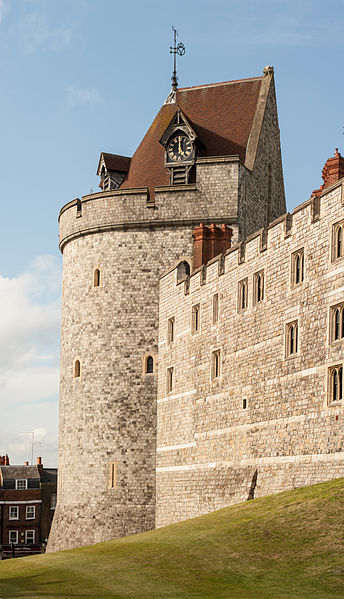
Back in the early 1970s I knew the old guide at the Curfew Tower of Windsor Castle. He was called George Hudson. From around the ages of 13 - 16 I used to help him with the second floor of the Tower itself as an unofficial guide. The history of this building was surprisingly interesting, and quite often tourists would miss out on not visiting it. Among other things, it is the home of the "small" dungeons where beehive shaped stone cells can still be seen. One poor prisoner tried to make a hole in one of them but was unfortunately caught as he emerged through the guard room of the Curfew Tower. Nowadays, the dungeons are used for social occasions!
What follows is a listed, and "potted" description of the Curfew Tower. Here, I am only relying on memory. I may check for accuracy at some later date...
The Guard Room/The "First Floor" (excluding the dungeons which could be seen as being the "basement"). This was also the place where the bells were rung notably for Royal occasions.
1. On entering the Curfew Tower via the Horseshoe Cloister one could see the large round oak "Shield" to the right. It was said to have been carved in the time of Edward III. In the centre of the wooden Shield was the King's Insignia (or Badge) along with smaller insignias of the members of the Royal Order of the Garter surrounding it. One of the insignias is missing. The story goes that during the Peasants Revolt of 1381 it was removed because one of the Knights of the Order Garter had sided with the rebels against King Richard II.
2. In the Guard Room the ropes to pull the bells in the Curfew Tower were kept.
3. A long steep wooden stairs connected the Guard Room with the Second Floor. It was said to have been constructed in the very early part of 14th Century (1317.
The Second Floor.
4. Here, a cannon aimed at Windsor Bridge is stationed. In the old days it was a wooden bridge. The canon was said to have been salvaged from the Mary Rose itself.
5.The old woodwork in the Curfew Tower was specially treated with a chemical to preserve it from perishing through time. The actual chemical, or mixture remains unknown to this day. Indeed, a drawing of the Second Floor showing the woodwork in all its glory was produced, and published by "Ripley" in a newspaper. It made specific reference to the mystery concerning the treatment of wood.
6. The clock in the Curfew Tower was constructed in the late 17th Century by John Davis. Opposite it were two arched windows through which people were hung!
7. There is a tunnel, or Sally Port under the Curfew Tower which most tourists do not see as it is usually closed to the public. However, George Hudson showed me it, and it proved to be rather interesting. Unfortunately, it is now blocked..
The above are the key features of the Curfew Tower. I cannot recall much more. But I do remember once looking out of a window next to the Curfew Tower to see a square grey stone had quite literally fallen out of it. If a pedestrian had been walking exactly under it...death would probably have been instant!
Incidently, George Hudson also managed to get me a pass to see the procession of the Members of the Order of the Garter back in 1975. It included the Royal Family whom I took photos of with my cheap Kodak camera....Security was very light unlike now I suspect.
Some Links
People ringing the bells in the Guard Room of the Curfew Tower https://www.youtube.com/watch?v=10gp5JOKokU
A special commissioned architectual survey of the Curfew Tower https://www.plowmancraven.co.uk/projects/curfew-tower-windsor-castle
A series of short articles which include one on the Curfew Tower plus some photos
http://www.canterburytrust.co.uk/the-business/built-heritage/planning_process/
The two following links here have some interesting pics, and "stories" in connection with the Curfew Tower
http://www.victorianweb.org/art/illustration/delamotte/13.html
http://www.victorianweb.org/art/illustration/cruikshank/windsor/14.html
An official authorized article on the Curfew Tower from St. George's Chapel itself which stands virtually opposite it in Hourseshoe Cloister
https://webcache.googleusercontent.com/search?q=cache:RV6g8X1_584J:https://www.stgeorges-windsor.org/image_of_the_month/the-curfew-tower/+&cd=5&hl=en&ct=clnk&gl=uk
Underground tunnels at Windsor Castle https://www.tapatalk.com/groups/theroyalwindsorforum/here-s-the-real-underground-tunnel-into-the-castle-t1477.html
Images of the clock in the Curfew Tower from the local museum archive. http://windsormuseum.org.uk/collection/photographs-clock-in-the-curfew-tower/
A pic of the dungeons which incidently houses a wooden stocks for miscreants http://windsormuseum.org.uk/collection/painting-the-dungeon-in-the-curfew-tower-dated-1890-1899/
PS. For some reason I seem to recall all of a sudden myself "crawling" about the very narrow inside of the battlements of the Curfew Tower with a very close view of the clock face. I do not know how George the old guide I "worked" for had the audacity to allow me to do such a thing... as I was essentially a child. It was quite dangerous...! Incidently, he used to be a soldier in World War II, and managed to get a job as the official guide to the Curfew Tower.
Various pics of the Curfew Tower on Google Images. In old paintings, and "ancient" photos instead of the Victorian "French- style" top of the Tower there used to be a cupola (shaped like a giant "pepperpot") which used to house the bells. https://www.google.co.uk/search?q=curfew+tower+windsor&safe=active&source=lnms&tbm=isch&sa=X&ved=0ahUKEwjQxcD6o_feAhXF26QKHURHAYMQ_AUIDigB&biw=1920&bih=985
What follows are two articles reproduced here. The one below gives reference to the Sally Port.

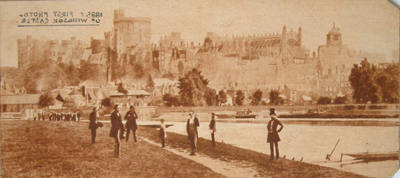
4. Here, a cannon aimed at Windsor Bridge is stationed. In the old days it was a wooden bridge. The canon was said to have been salvaged from the Mary Rose itself.
5.The old woodwork in the Curfew Tower was specially treated with a chemical to preserve it from perishing through time. The actual chemical, or mixture remains unknown to this day. Indeed, a drawing of the Second Floor showing the woodwork in all its glory was produced, and published by "Ripley" in a newspaper. It made specific reference to the mystery concerning the treatment of wood.
6. The clock in the Curfew Tower was constructed in the late 17th Century by John Davis. Opposite it were two arched windows through which people were hung!
7. There is a tunnel, or Sally Port under the Curfew Tower which most tourists do not see as it is usually closed to the public. However, George Hudson showed me it, and it proved to be rather interesting. Unfortunately, it is now blocked..
The above are the key features of the Curfew Tower. I cannot recall much more. But I do remember once looking out of a window next to the Curfew Tower to see a square grey stone had quite literally fallen out of it. If a pedestrian had been walking exactly under it...death would probably have been instant!
Incidently, George Hudson also managed to get me a pass to see the procession of the Members of the Order of the Garter back in 1975. It included the Royal Family whom I took photos of with my cheap Kodak camera....Security was very light unlike now I suspect.
Some Links
People ringing the bells in the Guard Room of the Curfew Tower https://www.youtube.com/watch?v=10gp5JOKokU
A special commissioned architectual survey of the Curfew Tower https://www.plowmancraven.co.uk/projects/curfew-tower-windsor-castle
A series of short articles which include one on the Curfew Tower plus some photos
http://www.canterburytrust.co.uk/the-business/built-heritage/planning_process/
The two following links here have some interesting pics, and "stories" in connection with the Curfew Tower
http://www.victorianweb.org/art/illustration/delamotte/13.html
http://www.victorianweb.org/art/illustration/cruikshank/windsor/14.html
An official authorized article on the Curfew Tower from St. George's Chapel itself which stands virtually opposite it in Hourseshoe Cloister
https://webcache.googleusercontent.com/search?q=cache:RV6g8X1_584J:https://www.stgeorges-windsor.org/image_of_the_month/the-curfew-tower/+&cd=5&hl=en&ct=clnk&gl=uk
Underground tunnels at Windsor Castle https://www.tapatalk.com/groups/theroyalwindsorforum/here-s-the-real-underground-tunnel-into-the-castle-t1477.html
Images of the clock in the Curfew Tower from the local museum archive. http://windsormuseum.org.uk/collection/photographs-clock-in-the-curfew-tower/
A pic of the dungeons which incidently houses a wooden stocks for miscreants http://windsormuseum.org.uk/collection/painting-the-dungeon-in-the-curfew-tower-dated-1890-1899/
PS. For some reason I seem to recall all of a sudden myself "crawling" about the very narrow inside of the battlements of the Curfew Tower with a very close view of the clock face. I do not know how George the old guide I "worked" for had the audacity to allow me to do such a thing... as I was essentially a child. It was quite dangerous...! Incidently, he used to be a soldier in World War II, and managed to get a job as the official guide to the Curfew Tower.
What follows are two articles reproduced here. The one below gives reference to the Sally Port.
Maggie Philbin takes an exclusive tour of the Castle /BBC
Here is an extract from the relevant part of the article.
.........Then we're off to the western end of Windsor Castle and the Curfew Tower with its 17th Century clock. With walls 13ft thick at the base and standing 100ft high, it was built between 1227 and 1230 as part of the new defences of the castle following the siege of Windsor during the reign of King John. So another climb up a perilously steep and uneven staircase which I have to tackle like a toddler, on hands and knees but watching the whirring cogs of the 17th Century clock is well worth the undignified climb. This clock, engraved with the words John Davis Windsor 1689 is the one which can still be seen on the tower, over 300 years since its installation. And after climbing back down, we head for an innocuous looking office but a trapdoor in the floor leads down to a wide, stone passageway with crumbling steps. It is the remnants of a Sally Port, or a secret exit for the occupants in a time of siege. IMPORTANT NOTE. Since the above on the Curfew Tower was published alot of new information has emerged about it from various sources. See the following links from Google Click the following...
|

The Curfew TowerPictures from 1770 and later

The famous 'pepper pot' shape of the Curfew Tower, at the far left of the castle from a panorama taken in the 1990s To see a larger version of this panorama, click here

A view of the castle from the 1850s showing the earlier square Curfew Tower belfry
This image, which claims to be 'the earliest photograph of Windsor', features in its own story here
One of the delights of looking after the Royal Windsor Website is that every so often some really early pictures come along that illustrate how the town and the castle have developed over the years. Four such images surfaced in July 2003 and one more in February 2007, from a variety of separate sources, illustrating, sometimes by accident, the Curfew Tower and nearby buildings.
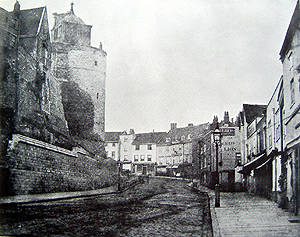
Thames Street and the earlier square belfry at the top of the Curfew Tower, often known as the Clewer Tower in earlier times, photographed by Arthur J Melhuish in 1856, seven years before work began on the Tower.
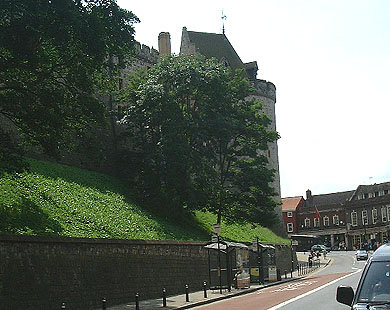
A similar view 144 years later in 2000
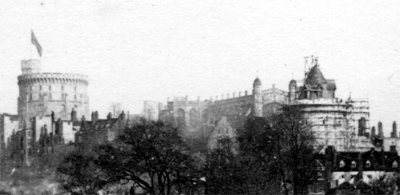
Curfew Tower surrounded by scaffolding
The picture above was found in an album containing pictures dated 1856 though this image is certainly later. Two dates are possible. The earlier is during the original construction of the new roof of the Curfew Tower in 1863, or later, from 1885, when further attention was required to the stone work of the west front, including the Curfew Tower. This additional attention was necessary because the stone facing work of 1860 was rapidly deteriorating. In 1859 the west front of the castle had been in a sorry state, the Garter Tower being in a very poor condition indeed. In 1860 therefore Anthony Salvin, was charged with restoring the west front as part of a general restoration of the Lower Ward. Unfortunately, the stone he chose for the job was just too soft and so in 1885 the Curfew, Garter and Salisbury Towers were refaced once again, this time with heath stone from High Wycombe. [Source Windsor Castle: Olwen Hedley, p. 201]
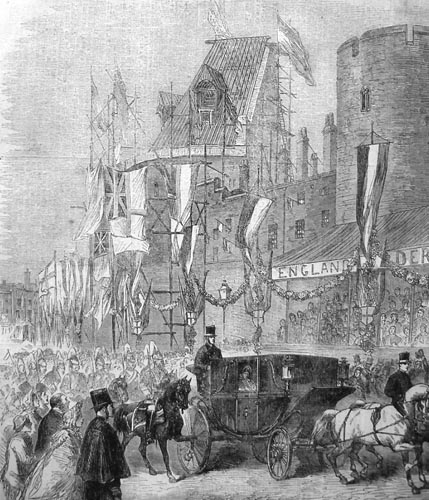
10 March 1863 and Princess Alexandra is riding in her carriage to St George's Chapel for her wedding to Prince Albert (to become Edward VII in 1901) and in the background is the Curfew Tower surrounded by scaffolding.
We believe that the following two images, taken from extremely rare stereoviews, show the stonemason's yard in the Lower Ward of the castle, and the carts used to take dressed stone through the Horseshoe Cloisters, to the top of the Curfew Tower.
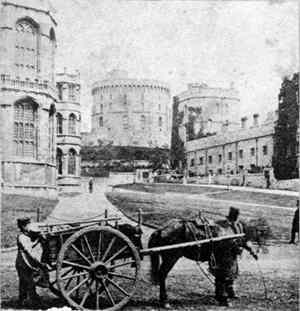
The picture above, taken from a stereoview, is also believed to date from 1863. A cart has just come out of the archway leading to the Horseshoe Cloisters. It was probably loaded with stone associated with the work on the Curfew Tower and west front. Note the figure sitting on the fence, extreme right, and the ghostly image of the horses head! It must have nodded as the photo was taken for photographic exposure times in those days were quite slow, often several seconds. Towards the middle left of the picture there is another figure who also appears in the picture below.
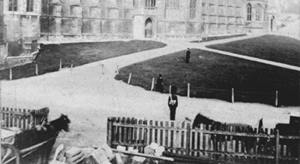
In this view, an extract from a second stereoview of the Lower Ward, the stones are clearly visible, fenced off from the public area. Also, note the soldier on guard, centre, and above him to the left, a figure seated by the fence. This same figure appears in the first picture above at the far right. We are satisfied that these two views were photographed on the same day, probably during the west front's restoration.
A Note about Stereoviews
Stereoviews provide a stereoscopic, 3D, effect when looked at through a viewer. Two images are required, one just to one side of the other, exactly as the human eye sees the view. The brain then combines the images and the 3D effect is created for the individual looking at the images. Some of the earliest stereoviews were created for the Great Exhibition of 1851 in London at the Crystal Palace. In the mid 20th century Viewmaster used the same principle with pairs of images incorporated into a disk which slotted into the viewer.
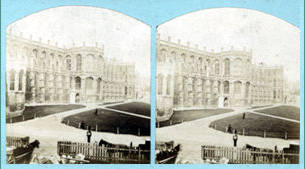
The original stereoview above came from a bundle of stereo cards. Those that were dated were all either 1858 or 1859. Early stereoviews were made flat, with square corners on the card mounts, until 1865. From 1865 to 1890 the cards were still flat but with rounded corners as the manufacturers learned that the corners would otherwise become 'bumped' and damaged. After 1890 the cards were made with curved mounts ('warped' stereoviews) as they felt they got better stereo and more strength.
Colour was very rare in Victorian times and could only be created by hand-tinting both images. The coloured stereo below is therefore very sought after.
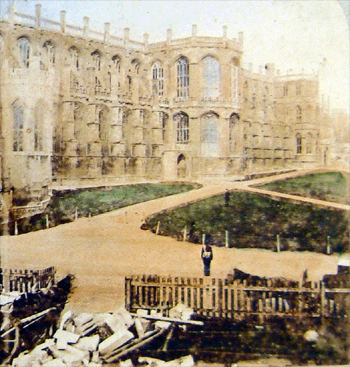
One of the delights of looking after the Royal Windsor Website is that every so often some really early pictures come along that illustrate how the town and the castle have developed over the years. Four such images surfaced in July 2003 and one more in February 2007, from a variety of separate sources, illustrating, sometimes by accident, the Curfew Tower and nearby buildings.
 Thames Street and the earlier square belfry at the top of the Curfew Tower, often known as the Clewer Tower in earlier times, photographed by Arthur J Melhuish in 1856, seven years before work began on the Tower.A similar view 144 years later in 2000  Curfew Tower surrounded by scaffolding
The picture above was found in an album containing pictures dated 1856 though this image is certainly later. Two dates are possible. The earlier is during the original construction of the new roof of the Curfew Tower in 1863, or later, from 1885, when further attention was required to the stone work of the west front, including the Curfew Tower. This additional attention was necessary because the stone facing work of 1860 was rapidly deteriorating. In 1859 the west front of the castle had been in a sorry state, the Garter Tower being in a very poor condition indeed. In 1860 therefore Anthony Salvin, was charged with restoring the west front as part of a general restoration of the Lower Ward. Unfortunately, the stone he chose for the job was just too soft and so in 1885 the Curfew, Garter and Salisbury Towers were refaced once again, this time with heath stone from High Wycombe. [Source Windsor Castle: Olwen Hedley, p. 201]
 10 March 1863 and Princess Alexandra is riding in her carriage to St George's Chapel for her wedding to Prince Albert (to become Edward VII in 1901) and in the background is the Curfew Tower surrounded by scaffolding.
We believe that the following two images, taken from extremely rare stereoviews, show the stonemason's yard in the Lower Ward of the castle, and the carts used to take dressed stone through the Horseshoe Cloisters, to the top of the Curfew Tower.

The picture above, taken from a stereoview, is also believed to date from 1863. A cart has just come out of the archway leading to the Horseshoe Cloisters. It was probably loaded with stone associated with the work on the Curfew Tower and west front. Note the figure sitting on the fence, extreme right, and the ghostly image of the horses head! It must have nodded as the photo was taken for photographic exposure times in those days were quite slow, often several seconds. Towards the middle left of the picture there is another figure who also appears in the picture below.

In this view, an extract from a second stereoview of the Lower Ward, the stones are clearly visible, fenced off from the public area. Also, note the soldier on guard, centre, and above him to the left, a figure seated by the fence. This same figure appears in the first picture above at the far right. We are satisfied that these two views were photographed on the same day, probably during the west front's restoration.
|
The Curfew Tower before 1863
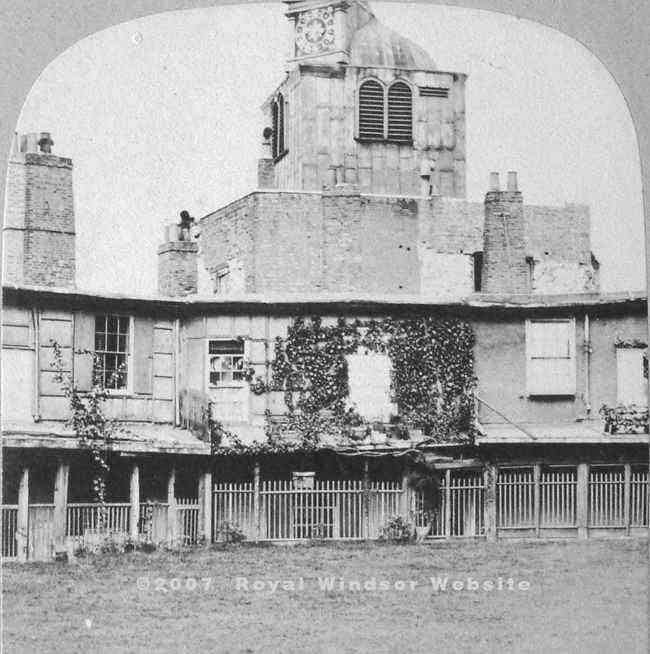
The Curfew Tower and Horseshoe Cloisters in the 1850s
from an exceptionally rare, early stereoview in the Royal Windsor Website Collection
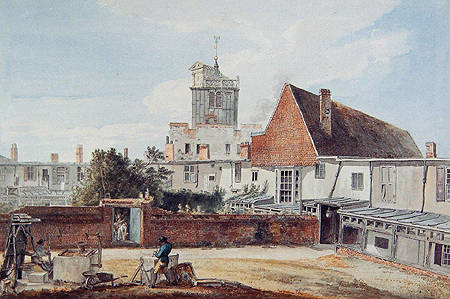
We are indebted to W H St John Hope and his major publication Windsor Castle (1913) for these references. St John Hope was not impressed with the new Victorian roofline and refacing of the Curfew Tower writing in 1913 of the 'disfigurement' of the original structure.
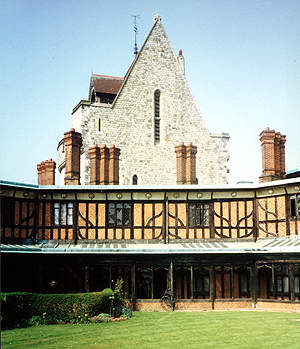
A view of the Curfew Tower from within the Horseshoe Cloister in 2000
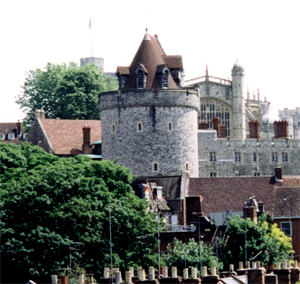
The Curfew Tower from the Central Railway Station
The Curfew Tower was originally built between 1227 and 1230 and was for several centuries known as the Clewer Tower. Later it was also known as the Bell Tower as it was the belfry for St George's Chapel during its construction in the reign of Edward IV in about 1474.
The present roof was copied from La Tour du Trésau, Carcassonne, France at the suggestion of Albert, The Prince Consort. It is likely that he was given the idea by Emperor Napoleon III who had made a State Visit to Windsor in 1855 while the Carcassonne tower was being repaired.
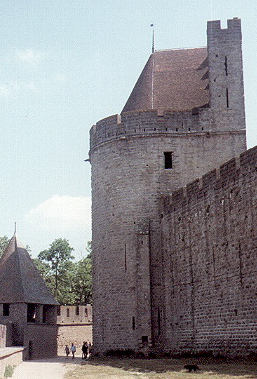
La Tour du Trésau (The Treasury Tower)
This tower is one of the most beautiful and imposing towers in the city of Carcassonne. It gave Prince Albert the idea for the roof line for the restored Curfew Tower at Windsor in 1863. [Carcassonne Web Site]
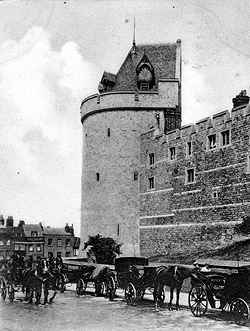
A remarkably similar view of the Curfew Tower taken in around 1900.
A modern taxi rank remains to this day as do the iron bars set in the curb to stop the horse-drawn cabs from running back down the hill. [2003]
The History Zone Index
Royal Windsor Home Page

To contact us, email Thamesweb.
-
|
 We are indebted to W H St John Hope and his major publication Windsor Castle (1913) for these references. St John Hope was not impressed with the new Victorian roofline and refacing of the Curfew Tower writing in 1913 of the 'disfigurement' of the original structure.   The Curfew Tower was originally built between 1227 and 1230 and was for several centuries known as the Clewer Tower. Later it was also known as the Bell Tower as it was the belfry for St George's Chapel during its construction in the reign of Edward IV in about 1474. The present roof was copied from La Tour du Trésau, Carcassonne, France at the suggestion of Albert, The Prince Consort. It is likely that he was given the idea by Emperor Napoleon III who had made a State Visit to Windsor in 1855 while the Carcassonne tower was being repaired. 
To contact us, email Thamesweb. |


Comments
Post a Comment